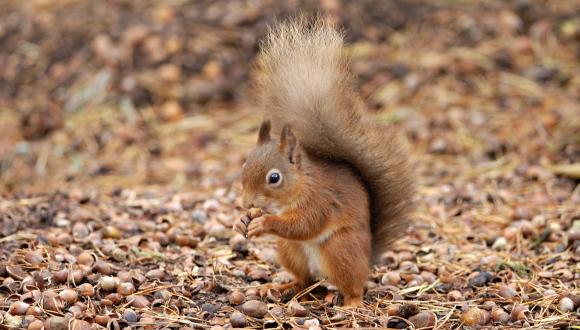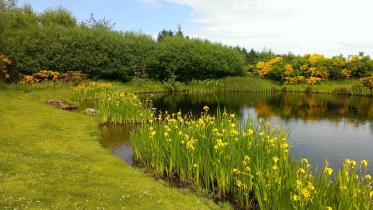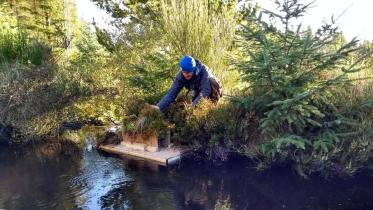Standing advice for planning consultations - Red Squirrels
This is standing advice to help planning applicants seeking permission for development that could affect red squirrels, and to assist planning officers and other regulators in their assessment of these applications
This is standing advice to help planning applicants seeking permission for development that could affect red squirrels and to assist planning officers and other regulators in their assessment of these applications. It avoids the need for us to advise on individual planning consultations in relation to red squirrels. We will only provide further advice in exceptional circumstances that are not covered by this standing advice.
Consideration of protected species in development management
Scottish Planning Policy requires that the presence (or potential presence) of legally protected species is factored into the planning and design of development proposals and that any impacts on protected species are fully considered prior to the determination of planning applications.
Where impacts on a protected species cannot be avoided, certain activities may only be undertaken with a licence from NatureScot. It is important that any licensing issues are considered as part of a planning application to avoid any unnecessary delay to a development proceeding.
Legal protection for red squirrels
Red squirrels and their dreys are protected by the Wildlife and Countryside Act 1981(as amended) and by the Nature Conservation Act 2004. It is an offence to intentionally or recklessly:
- kill, injure or capture a red squirrel;
- disturb a red squirrel in a drey;
- damage, destroy or obstruct access to a red squirrel drey.
This means that if red squirrels could be affected in these ways by a development and no action is taken to prevent it, an offence may be committed. The advice below will help ensure that impacts on red squirrels are minimised and no offences occur.
When a development could affect red squirrels
Red squirrels can occur in various types of woodland, including gardens and parkland. There are though large parts of Scotland where red squirrels don’t occur and so won’t be an issue, including most of the Central Belt, parts of the North West Highlands, and all the islands except Arran. For an up to date map of red squirrel distribution see the National Biodiversity Network Atlas. The NBN Atlas map indicates the broad pattern of distribution across Scotland but cannot provide detailed information for individual development sites. Local Record Centres may have additional information that can help determine if red squirrels are likely to be present. See also the Atlas of the Mammals of Great Britain & Northern Ireland (The Mammal Society/Pelagic Publishing 2020).
Where red squirrels might be present, you will only need to consider them if a proposal includes either of following:
- felling trees that have a reasonable chance of containing dreys - suitable trees are usually 15 years or older and can be conifer or broadleaf species, or
- felling and other works that could disturb dreys. This is likely to be where works are within 50m of trees containing a drey during the red squirrel breeding season (February to September inclusive). If works are confined to the non-breeding season then the risk of disturbing red squirrels is much lower and only likely to occur where works are within 5m or one tree’s distance of a potential drey location (whichever is less).
A red squirrel survey should be carried out if a proposal could potentially impact on red squirrels in these ways.
Carrying out a red squirrel survey
Surveys should be done by persons with the appropriate knowledge of red squirrel ecology and practical experience of red squirrel survey work. Surveys can be carried out at any time of year, as red squirrels are active all year round. However, it is quicker and easier to survey broadleaved or larch woodland in the winter when the squirrels and their dreys are more easily seen. Surveys of squirrel activity should start as soon after first light as possible, as this is the time when squirrels are most likely to be active. Avoid surveying in heavy rain, strong winds or when it is very cold, as red squirrels are less likely to be active.
The nature of the survey required will depend on what prior knowledge there is regarding the presence of red squirrels within the development site. The flow diagram at the end of the advice note describes a hierarchy of survey methods to minimise the need for unnecessary surveys, and to allow the application of the least time consuming method appropriate to the circumstances. This can range from a simple check for presence or absence of red squirrels to a more detailed systematic search for squirrel dreys and checks for breeding activity.
In areas with both red and grey squirrels, care should be taken to distinguish between the two species, as colouring varies and they can be difficult to tell apart. Feeding signs of red and grey squirrels are very similar and the species cannot be distinguished from signs alone in areas where both occur. It isn’t possible to distinguish between red and grey squirrel dreys from their appearance. So if both species are present, all dreys should be treated as if they are protected, unless it can be demonstrated beyond reasonable doubt that the drey is only used by grey squirrels.
Hair tubes can be used to distinguish between red and grey squirrel activity where they are difficult to see. These are baited, sticky tubes that collect hair from a squirrel as it reaches in. The hairs can then be identified as red or grey squirrel. Hair tubes are not recommended for use in areas with squirrelpox virus as they may aid the spread of the disease. Squirrelpox virus is currently in south Scotland and encroaching on central Scotland.
It will be necessary to check if dreys are currently being used by red squirrels if the works will result in damage or destruction of dreys at any time of year, or where disturbance to dreys during the breeding season cannot be avoided, and a licence for such works has been granted by NatureScot. Observations of dreys should be made over at least three dawns in suitable weather conditions to establish use, either using direct observations, video or suitably sited trail cameras. Intrusive methods such as endoscopic inspection should only be used where other methods are not possible. Endoscopic inspection of dreys, and positioning remote cameras close to dreys, can cause disturbance and will require a survey licence from NatureScot (contact [email protected]).
The survey information needs to be sufficiently up-to-date when a planning application is submitted. Pre-application red squirrel surveys normally remain valid for two years, and should be repeated if the application is delayed beyond that. Unless it is clearly evident that there has been no substantive change in number, distribution or activity of red squirrels since the original survey was undertaken.
For further details regarding survey methods see Practical techniques for surveying and monitoring squirrels (Forestry Commission 2009).
Reporting survey results
If a development proposal has needed a red squirrel survey, a survey report must be submitted as part of the planning application. The report should include:
- names and experience of surveyors;
- details of any information gathered from Local Record Centres or other sources;
- descriptions of habitat surveyed and any limitations to the survey, such as access;
- survey methods, including survey area, date, time and weather conditions;
- a map showing the location of any transects and any records of red or grey squirrels, their dreys and feeding signs in relation to the development;
- an assessment of how the development might affect red squirrels.
If red squirrels could be affected by the proposal, the report must include a protection plan. The plan should include:
- measures proposed to minimise impacts on red squirrels, including annotated maps and/or photographs showing the location of any measures proposed and how they relate to survey information and construction work;
- a summary of any residual impacts once the above measures are taken into account;
- details of any licensing requirements.
Measures to minimise impacts on red squirrels
Measures to minimise impacts on red squirrels should follow a hierarchy of avoidance, mitigation and compensation:
Avoidance
- Design the development and construction methods to avoid or minimise the felling of trees and ground works within forest habitat, and maintain habitat corridors.
- Avoid felling any trees containing red squirrel dreys. Works will otherwise require a licence from NatureScot before they can proceed.
- Schedule works between October–January inclusive, so they are outwith the breeding season and will avoid disturbance of breeding dreys.
Mitigation
- If works need to take place during the breeding season, mark 50m work exclusion zones around any breeding dreys. If monitoring confirms the drey is not used for breeding, smaller protection zones will be required (5m or to the nearest neighbouring tree, whichever is less). Where exclusion zones of the required size aren’t possible, works will require a licence from NatureScot before they can proceed.
Compensation
- Create new woodland habitat where there is significant tree felling and loss of existing habitat. Conifers benefit red squirrels most (eg. Douglas fir, pines, spruces, larches and yew). Avoid planting large seeded trees which would benefit non-native grey squirrels that outcompete red squirrels (eg. beech, chestnuts, hazel, oak & sycamore).
For all development proposals where red squirrels are a consideration, pre-construction surveys should be timetabled into project plans. This is to enable checks for any new dreys that may have become occupied after the original survey, and to ensure the measures proposed to minimise impacts on red squirrels remain appropriate. Pre-construction surveys should be completed as close to the construction period as possible, and no more than 3 months before the start of works. Red squirrels can move dreys during the breeding season, so a non-breeding drey could change status. Any dreys affected should therefore be re-surveyed every 3 weeks to confirm status during the breeding season.
Further detail regarding these measures can be found in UK BAP Mammals: Interim Guidance for Survey Methodologies, Impact Assessment and Mitigation (The Mammal Society 2012).
Licensing development works affecting red squirrels
Licences for development works that would otherwise result in an offence with respect to red squirrels can only be issued if:
a) the development will give rise to significant social, economic or environmental benefit (see Protected Species Licensing: Licences for ‘social, economic or environmental purposes’) and
b) there is no other satisfactory solution.
There is a presumption against licensing disturbance or damage/destruction of a breeding drey. If there is no alternative to carrying out works in the breeding season, monitoring would be required to confirm that the drey is not in use, or is not being used for breeding. The likely conservation impact on the local red squirrel population will also be considered in assessing a licence application.
For advice on whether or not a licence is likely to be granted, planning applicants and planning officers may contact the NatureScot licensing team. An up-to-date red squirrel survey and a red squirrel protection plan for the proposed development must be submitted with the enquiry, together with details of the development proposals. We would normally only expect these enquires when proposals may reduce available red squirrel habitat to such an extent that the local population viability may be affected and/or trapping and translocation may be required.
Guidance on applying for a red squirrel licence for development purposes, along with the application form can be found on our website. For further information on protected species licensing see Protected Species Licensing: Legislation, Appropriate Authorities and Licensing Purposes.
Hierarchy of red squirrel survey requirements
- Do you know that red squirrels are present on the development site, from your own observations, local information or NBN records?
- Yes, red squirrels present - survey site for dreys; and go to 4.
- Not sure - survey site for feeding signs and dreys; and go to 2.
- Do feeding signs and dreys indicate the presence of red squirrels?
- Yes, red squirrels present - go to 4.
- No, red squirrels absent - no further survey required.
- Not sure, feeding signs and dreys could be red or grey squirrel - carrying out line transect observations or use hair tubes or trail cameras at feeder boxes to check presence of red squirrels; and got to 3.
- Have line transects, hair tubes or trail cameras confirmed presence of red squirrels?
- Yes, red squirrels present - go to 4.
- No, red squirrels absent - no further survey required.
- Could red squirrel dreys be damaged or disturbed by the development, including any indeterminate red/grey squirrel dreys?
- Yes - go to 5.
- No - no further survey required.
- Can mitigation measures avoid disturbance and/or damage to any known or potential red squirrel dreys?
- Yes - no further survey is required.
- No - apply for a licence to disturb or damage dreys; this will require the identification of any red squirrel breeding dreys, which can only be disturbed or damaged outwith the breeding season.
Contact
If you already have a licence number, include it in the subject line of your email, or have it to hand when you call.






